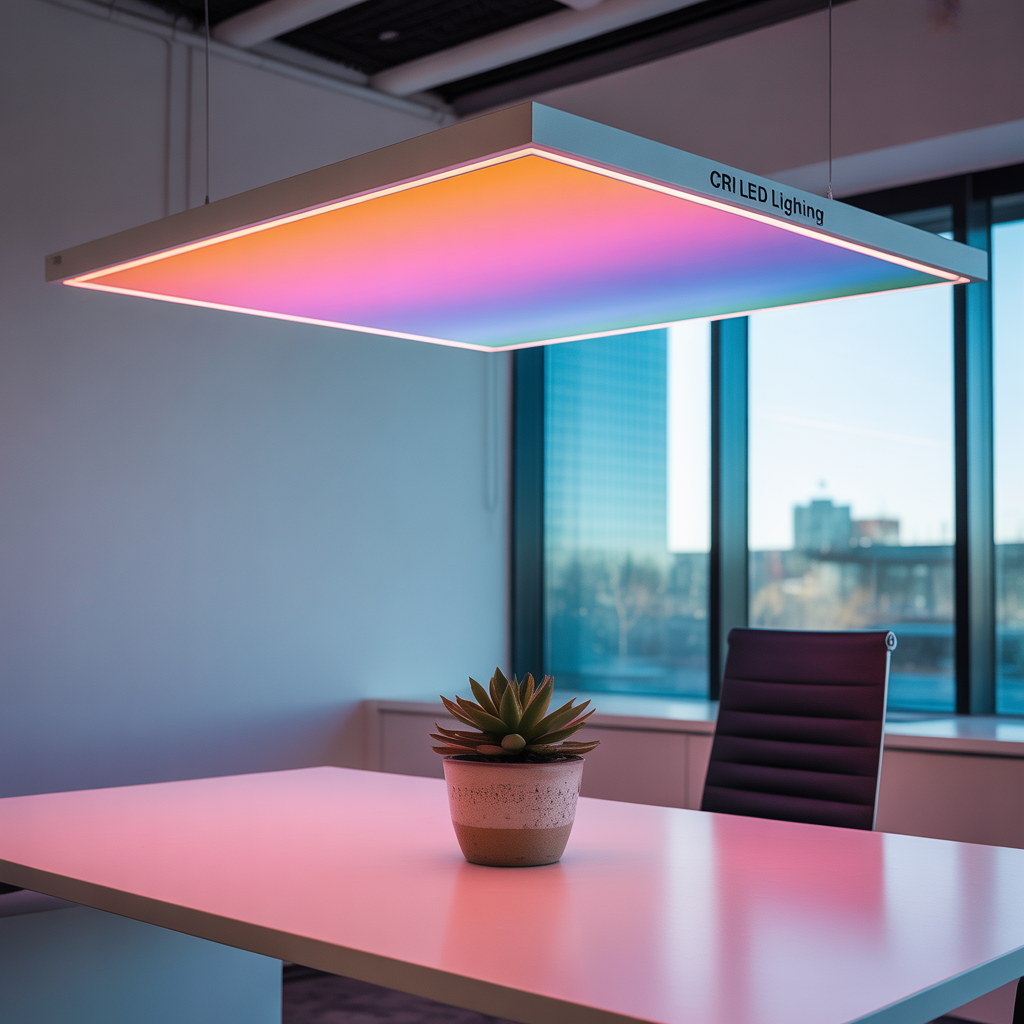What Is CRI LED Lighting? A Comprehensive Guide
Are you looking to improve the lighting in your home or workplace? Perhaps you’ve heard the term “CRI” mentioned in relation to LED lighting, but aren’t quite sure what it means. This comprehensive guide will delve into the world of CRI LED lighting, explaining what it is, why it’s important, and how it can impact…
Are you looking to improve the lighting in your home or workplace? Perhaps you’ve heard the term “CRI” mentioned in relation to LED lighting, but aren’t quite sure what it means. This comprehensive guide will delve into the world of CRI LED lighting, explaining what it is, why it’s important, and how it can impact your experience. We’ll cover everything from the technical aspects to practical applications, helping you make informed decisions about your lighting choices. By the end, you’ll understand CRI, its benefits, limitations, and how to choose the right lighting for your needs.
What is CRI LED lighting? CRI (Color Rendering Index) in LED lighting measures how accurately a light source reveals colors compared to natural sunlight. It ranges from 0 to 100, with higher values indicating better color accuracy. LEDs with a CRI of 90+ are ideal for tasks needing true color representation, like photography or design.
CRI, or Color Rendering Index, is a measurement scale that quantifies how accurately a light source renders the colors of an object compared to a reference light source. The reference source is usually daylight (CIE illuminant D65).
Think of it this way: imagine holding a red apple under different light sources. Under some lights, the apple might appear dull and brownish, while under others, it will look vibrant and red. CRI measures this difference – the higher the CRI value, the more accurately the light source renders the true colors of the object.
What Is CRI LED Lighting?
The CRI Scale: Understanding the Numbers

The CRI scale ranges from 0 to 100. A CRI of 100 indicates perfect color rendering, matching the colors under natural daylight. Lower CRI values mean the colors appear less accurate and potentially distorted.
-
- CRI 80-100: Excellent color rendering; suitable for most applications where accurate color perception is crucial (e.g., art galleries, retail spaces, hospitals).
- CRI 70-79: Good color rendering; acceptable for many general lighting applications.
- CRI below 70: Poor color rendering; suitable only for applications where color accuracy is not important (e.g., security lighting).
Read More: What Is a 12 W LED in Incandescent Light? Need to Know Everything
Why is CRI Important in LED Lighting?
LED lighting is incredibly versatile, offering energy efficiency and long lifespan. However, the color rendering capabilities of LEDs vary greatly depending on their design and the phosphors used. A high CRI LED ensures that the colors in your environment appear natural and vibrant, improving visual comfort and aesthetics.
In environments where accurate color perception is important, such as museums, hospitals, or retail stores, choosing high CRI LEDs is essential. Inaccurate color rendering can impact product displays, medical diagnoses, or artistic appreciation.
Types of LED Lights and Their CRI Values
Various types of LED lights are available, each boasting a different CRI. Some common types and their typical CRI ranges include:
-
- Warm White LEDs: Often have CRIs ranging from 80 to 95, offering a cozy and inviting atmosphere.
- Cool White LEDs: May have CRIs from 70 to 90, providing a brighter, more energetic feel.
- Natural White LEDs: Typically boast a CRI between 80 and 95, creating a balanced and natural lighting experience.
However, it’s crucial to check the CRI value of specific LED lights as it varies significantly between manufacturers and models.
Read More: Dimming An LED: What Electronics Component Would Fade an LED Light Bulb?
High CRI vs. Low CRI LEDs: A Comparison
| Feature | High CRI LEDs (CRI > 80) | Low CRI LEDs (CRI < 70) |
|---|---|---|
| Color Rendering | Accurate and natural color reproduction | Distorted and unnatural color reproduction |
| Visual Comfort | Enhanced visual comfort and aesthetics | Potentially strained vision and less appealing environment |
| Applications | Art galleries, hospitals, retail stores, homes | Security lighting, outdoor lighting where color accuracy isn’t crucial |
| Cost | Generally more expensive | Generally less expensive |
Benefits of High CRI LED Lighting
Choosing high CRI LEDs offers numerous advantages:
-
- Improved Color Accuracy: Objects appear in their true colors, enhancing the visual experience.
- Enhanced Visual Comfort: Natural-looking light reduces eye strain and improves mood.
- Better Aesthetics: Creates a more pleasing and inviting atmosphere.
- Improved Productivity: In work environments, accurate color perception can boost productivity and efficiency.
Limitations of High CRI LED Lighting

While high CRI LEDs offer many benefits, there are some potential drawbacks:
-
- Higher Cost: High CRI LEDs are generally more expensive than low CRI LEDs.
- Lower Efficacy (in some cases): Some high CRI LEDs may have slightly lower luminous efficacy (lumens per watt) than low CRI LEDs, meaning they consume slightly more energy to produce the same amount of light.
These limitations should be considered, particularly in large-scale projects or when budget constraints are a primary concern.
Read More: 12 Creative Hallway Ceiling Light Ideas & Hacks
How to Choose the Right CRI LED Lighting
Selecting the appropriate CRI for your needs depends on the intended application.
-
- For applications requiring accurate color reproduction (e.g., art galleries, hospitals, food preparation areas), opt for LEDs with a CRI of 90 or higher.
- For general lighting applications where perfect color accuracy isn’t paramount, LEDs with a CRI of 80 or higher are usually suitable.
- For purely functional lighting (e.g., security lighting, outdoor pathway lights), a CRI of 70 or higher may be acceptable.
CRI and Color Temperature
CRI and color temperature are distinct yet related aspects of LED lighting. Color temperature is measured in Kelvin (K) and refers to the perceived warmth or coolness of the light. While a high CRI ensures accurate color rendering, the color temperature influences the overall mood and appearance of the light. A warm white light (around 2700K) often feels inviting, whereas a cool white light (around 6500K) can feel more energetic.
CRI LED Lighting Applications
High CRI LED lighting finds applications in diverse sectors:
-
- Retail: Accurate color rendering enhances product displays, leading to increased sales.
- Healthcare: Precise color perception is crucial for medical diagnoses and procedures.
- Museums and Art Galleries: Preserves the true colors of artwork and artifacts.
- Hospitality: Creates a comfortable and aesthetically pleasing environment for guests.
- Residential: Enhances the overall ambiance and visual comfort of homes.
Measuring CRI: Methods and Tools
While you typically rely on manufacturers’ specifications, specialized equipment is required for precise CRI measurements. Spectrophotometers are instruments that measure the spectral power distribution of light, from which the CRI can be calculated. These instruments are commonly used in lighting labs and research facilities.
CRI and Energy Efficiency
While higher CRI LEDs might, in some cases, have slightly lower luminous efficacy compared to low CRI counterparts, the overall energy efficiency of LED lighting remains significantly higher than traditional lighting technologies like incandescent or fluorescent bulbs. This energy saving is a crucial factor to consider when evaluating your lighting choices, outweighing any minor efficiency differences associated with higher CRI values.
Common Misconceptions about CRI
Many believe that a higher CRI automatically means better light quality. While a high CRI is generally desirable, it’s not the sole factor determining light quality. Other factors like color temperature and uniformity also contribute to the overall visual experience. Focusing solely on CRI without considering these aspects can lead to misleading conclusions.
Future Trends in CRI LED Lighting
Research and development continue to improve the efficiency and color rendering capabilities of LEDs. We can expect advancements in materials and manufacturing processes to further enhance CRI values while maintaining or improving energy efficiency.
Frequently Asked Questions
What is CRI LED lighting used for?
CRI LED lighting is used in a wide array of applications, from residential lighting to commercial settings requiring accurate color rendering, such as retail stores, museums, hospitals, and art galleries. It’s valuable wherever true-to-life color reproduction is critical.
How does CRI affect my vision?
High CRI lighting reduces eye strain because it provides more natural-looking light. Low CRI lighting can make colors appear distorted and can lead to visual fatigue over time.
Is a higher CRI always better?
While a higher CRI generally indicates better color rendering, it’s not always necessary. The ideal CRI depends on the application. In areas where color accuracy is paramount (e.g., a photography studio), a higher CRI is crucial, but for basic lighting needs, a slightly lower CRI might be sufficient.
How can I find the CRI of an LED bulb?
The CRI value is usually printed on the packaging of the LED bulb or listed in its specifications on the manufacturer’s website. Look for the abbreviation “CRI” followed by a number (e.g., CRI 90).
What is the difference between CRI and color temperature?
CRI measures the accuracy of color rendering, while color temperature measures the warmth or coolness of the light (measured in Kelvin). High CRI ensures accurate color representation regardless of the color temperature.
Are high CRI LEDs more expensive?
Generally, yes. High CRI LEDs tend to be more expensive than low CRI LEDs due to the more complex manufacturing processes involved in producing higher-quality phosphors that result in better color rendering.
Can I use low CRI LEDs everywhere?
No. While low CRI LEDs are suitable for applications where color accuracy is less critical, such as security lighting or some outdoor spaces, they are not ideal for environments where accurate color representation is necessary, as this can impact tasks and perceptions.
Final Thoughts
Understanding CRI in LED lighting is crucial for making informed choices about your lighting needs. High CRI LEDs offer significant advantages in terms of color accuracy, visual comfort, and aesthetics, particularly in environments where precise color representation is essential. While they may come at a slightly higher cost, the benefits often outweigh the expense, particularly in the long run considering the improved visual experience and potential increased productivity or sales in commercial applications. When selecting LED lighting, remember to check the CRI value alongside color temperature to ensure you choose the best option for your specific application. By understanding the nuances of CRI, you can create a visually appealing and comfortable environment with lighting that truly enhances your space. Consider the specific requirements of your environment and prioritize the CRI level accordingly. Investing in high-quality lighting with excellent CRI will benefit you in terms of visual comfort, work efficiency, and the overall aesthetic of your space. So, make an informed choice and light up your world with high-quality CRI LED lighting!

